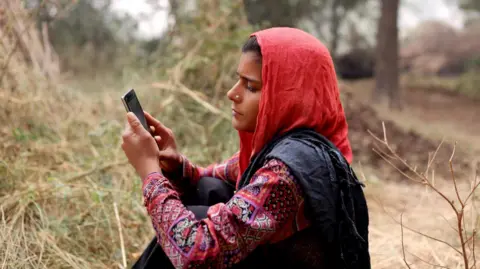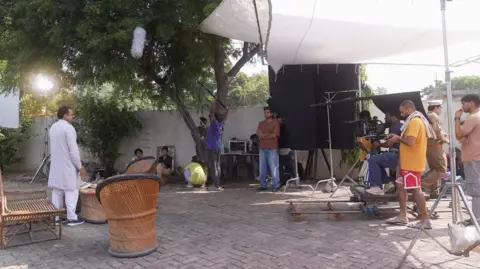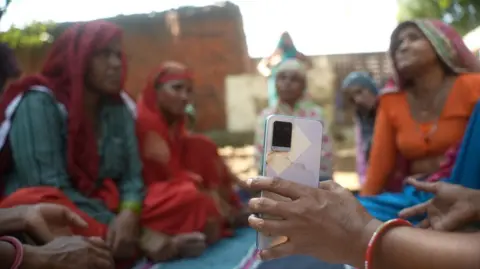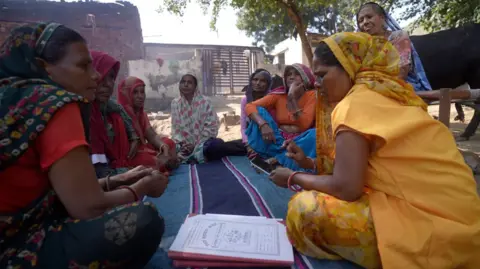 Getty Images
Getty ImagesThe tiny villages of Haryana state in India’s rural north-west find themselves in an unlikely spotlight these days.
Farmers’ homes in hamlets around the industrial town of Rohtak are suddenly in demand, doubling up as movie sets.
Alongside the mooing of cows, it isn’t unusual to hear a director shouting “lights, camera, action” here.
A new start-up, called STAGE, has spawned a nascent film industry in this hinterland.
“Batta”, a high-octane drama about power and injustice, is just the latest in half-a-dozen movies under production in the area, Vinay Singhal, founder of STAGE , told the BBC on the film’s sets.
“There were just a dozen odd Haryanvi films made in India’s history before we came in. Since 2019, we’ve made more than 200,” says Mr Singhal.
STAGE makes content for largely under-served provincial audiences, keeping hyper-local tastes, dialectical quirks and the rural cultural syntax in mind.
There are 19,500 different dialects in India, and STAGE has identified 18 that are spoken by a large enough population to merit their own film industry.
The app currently offers content in two languages – Rajasthani and Haryanvi. It has three million paying subscribers and is planning to expand and include other dialects like Maithili and Konkani, which are spoken in north-east and coastal-west India, respectively.
“We’re also on the verge of closing a funding round from an American venture capitalist firm to expand into these territories,” says Mr Singhal, who appeared along with his co-founders on the Indian version of Shark Tank, a business reality show, a year ago.
 Saraskanth TK
Saraskanth TKSTAGE is one among a growing number of Indian start-ups that are betting big on the rural market opportunity as the next growth frontier. Others include players like Agrostar and DeHaat.
While a bulk of India’s 1.4 billion people still live in its 650,000 villages, they’ve hardly been a market for its booming tech start-ups so far.
Asia’s third-largest economy has been a hotbed for innovation, birthing several dozen unicorns – or tech companies valued at over $1bn – but they’ve all largely built for the “top 10%” of urban Indians, according to Anand Daniel, partner at Accel Ventures, which has funded some of the country’s most successful ventures, from Flipkart to Swiggy and Urban Company.
While there have been notable exceptions like online marketplace Meesho, or a few farm technology players, the start-up boom has largely bypassed India’s villages.
That’s now changing as more founders successfully cater to rural consumers and get funded for their ideas.
“Investors don’t show you the door anymore,” says Mr Singhal.
“Five years ago, I didn’t get any money at all. I had to bootstrap the company.”
Accel itself is now cutting more cheques to entrepreneurs solving for the rural market, recently announcing it will invest up to $1m in rural start-ups through its pre-seed accelerator programme.
Unicorn India Ventures, another local VC fund, says 50% of their investments are now in start-ups based in tier 2 and tier 3 cities. And in July this year, the Japanese auto giant Suzuki announced a $40m India fund to invest in start-ups building for rural markets.
 Saraskanth TK
Saraskanth TKSo what’s driving this shift?
The untapped market opportunity is large, says Mr Daniel, and there’s a growing realisation among investors and founders that rural doesn’t necessarily mean poor.
Two-thirds of India’s population live in the hinterland and spend about $500bn annually. In fact, the top 20% of this demographic spends more money than half of those that live in the cities, according to Accel’s own estimates.
“As India adds $4tn to GDP over the next decade, at least 5% of that will be digitally influenced, and coming from ‘Bharat’ or rural India,” says Mr Daniel.
That’s a $200bn incremental opportunity.
Giving tailwind to this is the growing penetration of smartphones among middle-income rural families.
Some 450 million Indians now use one outside its cities – which is more than the entire US population.
And click-of-a-button digital payments through the much-touted UPI interface has been a game-changer for companies looking beyond the metros to expand their offering.
“Five or seven years ago, the ability to reach this target group – be it digitally, logistically or in terms of getting payments – wasn’t easy. But the timing right now is much better for this generation of start-ups trying to address this market,” says Mr Daniel.
Also, while most innovation was happening in cities like Mumbai and Bengaluru a decade ago, a growing number of entrepreneurs are now emerging from smaller towns, driven by factors such as lower operating costs, availability of local talent, and government initiatives aimed at promoting entrepreneurship in non-metro areas, according to a report from Primus Ventures.
Being close to the ground may have also contributed to exposing founders to the potential of the vast non-metro market.
 Saraskanth TK
Saraskanth TKBut cracking rural India is easier said than done.
The small town consumer is price-conscious and geographically dispersed. The number of addressable consumers in any given postcode is far smaller than the cities.
Infrastructure also continues to lag, so “distribution isn’t easy, and operating costs are high”, says Gautam Malik, chief revenue officer at Frontier Markets, a rural e-commerce start-up that does last-mile deliveries to villages with populations below 5,000.
Besides, those using urban templates and force-fitting them to the village context will fail, says Mr Malik.
His company quickly realised why traditional e-commerce wasn’t able to penetrate the very last mile. The village customer simply didn’t trust her money with a third party that didn’t have local presence.
To build that trust factor, Mr Malik and his team had to tie up with village-level women entrepreneurs to act as their sales and delivery agents.
Such differentiation and a commitment for the long haul will be critical, he says, to winning rural India and cracking that incremental $200bn market opportunity.
Follow BBC News India on Instagram, YouTube, Twitter and Facebook.

